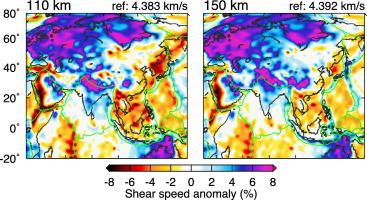当前位置:
X-MOL 学术
›
Earth Sci. Rev.
›
论文详情
Our official English website, www.x-mol.net, welcomes your
feedback! (Note: you will need to create a separate account there.)
The upper mantle beneath Asia from seismic tomography, with inferences for the mechanisms of tectonics, seismicity, and magmatism
Earth-Science Reviews ( IF 10.8 ) Pub Date : 2024-06-18 , DOI: 10.1016/j.earscirev.2024.104841 Hui Dou , Yihe Xu , Sergei Lebedev , Bruna Chagas de Melo , Robert D. van der Hilst , Baoshan Wang , Weitao Wang
Earth-Science Reviews ( IF 10.8 ) Pub Date : 2024-06-18 , DOI: 10.1016/j.earscirev.2024.104841 Hui Dou , Yihe Xu , Sergei Lebedev , Bruna Chagas de Melo , Robert D. van der Hilst , Baoshan Wang , Weitao Wang

|
The structure and dynamics of the upper mantle control tectonics, seismicity, magmatism, and the development of mineral deposits. Seismic tomography maps spatial variations in seismic velocity and offers essential information on the variations of temperature in the mantle, the thickness and mechanical strength of the lithosphere, and the convection patterns below it. Thanks to the growth in the station coverage, tomographic models of Asia reveal increasingly detailed structures, in particular in its best-sampled parts. Here, we present a new waveform tomography model, , constrained by massive global and regional datasets. The data coverage used to construct is maximised across the hemisphere centred at Asia. In China, in particular, dense national network data enhances the sampling. Our waveform tomography extracts structural information from surface waves and from S and multiple S body waves. The effects of errors are suppressed by statistical and targeted outlier analyses and the removal of the least mutually consistent data. Extensive comparisons of contemporary tomographic models reveal both consensus features and differences between models and demonstrate relative advantages of different approaches and data types. advances the resolution of the imaging compared to the state of the art at the scale of the continent. A prominent high-velocity anomaly at lithospheric depths shows the Indian cratonic lithosphere underthrusting and subducting beneath Tibet. In the transition zone below the plateau, a fragmented high-velocity anomaly indicates lithospheric remnants, probably from different phases of subduction. The lithosphere beneath most diamondiferous kimberlites—originally emplaced on thick cratonic lithosphere—is observed to be still thick at present. Relatively low velocities at kimberlite locations are indicative of craton-lithosphere thinning and are detected beneath northwestern Siberian Craton (Siberian Traps) and most of the Indian Shield (Deccan Traps and surroundings), with the exception of the intact cratonic lithosphere beneath northeastern Dharwar Craton. This suggests that the mantle plumes responsible for the traps have eroded the deep cratonic lithosphere. Thin lithosphere and recent basaltic volcanism are observed in eastern Sino-Korean and Yangtze Cratons, with subduction, stretching, and rifting likely to have weakened and modified their cratonic roots. Cenozoic basalts are found exclusively where the lithosphere is observed to be thin. Beneath the Hainan volcanic region, a low-velocity anomaly is observed throughout the upper mantle, consistent with the previously proposed Hainan Plume feeding the magmatism. The shape of the anomaly indicates a complex morphology of the upwelling. Low-velocity anomalies in the mantle transition zone beneath the Hangai Dome and southern Siberian Craton are consistent with hot upwelling(s) and horizontal asthenospheric flow feeding the dispersed basaltic volcanism. Sediment-hosted metal deposits tend to be located near contrasts in the thickness of the lithosphere, including craton boundaries and other substantial heterogeneities. Intraplate seismicity is controlled by plate-boundary stresses and lateral variations of the lithospheric thickness and strength. Areas with relatively thin lithosphere across Asia tend to localise deformation and seismicity. The Gujarat seismic zone in India is collocated with an area of warm, thin lithosphere. This suggests a relationship between the occurrence of devastating earthquakes there and deformation in the mechanically weak part of the plate.
更新日期:2024-06-18











































 京公网安备 11010802027423号
京公网安备 11010802027423号